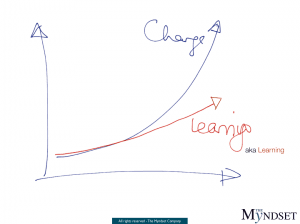If Human Resources — and internal corporate universities — are still busily creating trainings and seminars to help managers to come to grip with the inevitable digital transformation, as Brian Solis likes to say, the real issue is to find ways for learning to be happening in between those sessions. It’s not to say that team-building, IRL (“in real life”) seminars do not have their place. It’s just that we can no longer rely on that kind of learning to keep up with the pace of change. Moreover, from an employee engagement point of view, learning is the one thing that keeps us young. In a survey I did with about 100 20-25 year olds, nearly half of them cited the desire “to be learning every day” at their (future) employer as a condition for remaining at the company. And this is before they have even stepped inside the door! But, the truth is that we would all rather be learning every day. I say: bring back the kid in us all!
How to create a continuous learning mindset and environment?
There are lots of interesting options for continuous learning to be taking place:
- daily newsletters
- mentoring programs
- reverse mentoring programs
- coaching
- online or eLearning
- mobile learning
- webinars
- the Digital Cafe (e.g. 30 minutes with an internal digital expert at the cafeteria)
- internal social media network (yammer, internal blog, etc…)
- external social media (Twitter, blogs, etc.)
- …
The future of learning is positively exciting. There are any number of ways to embed learning into every day life at work. The biggest challenge, however, is mindset. The employees must be delegated to craft their own learning programs and uncover their own content. The company’s role is to make the tools and content available. The employee must be made responsible to seek the right materials for his/her needs. The issue we have in this new context is that much of the content relates to new technologies. Just as there is no handbook for the internet (or an apple device), there is no replacement for going out and learning by trying. {Click to Tweet!} The internet, for example, is learned by living and doing it, not by reading about it.
3 ways to encourage continuous learning
The majority of learning — as we all know — happens socially. The best learning happens when we are having fun. It also needs to happen when, where and how we want it. I wrote previously here about the 7 guidelines to making great learning. The sine qua non of continuous learning is to have quality curated content that is made available across devices and platforms within the organization. {Click to Tweet} Beyond that, here are three keys to get that kind of continuous learning to happen:
- be creative in the way the learning can be consumed (i.e. in form and function)
- sharing should be rewarded (as in recognition)
- provide for topics that are more personal (e.g. on sleep and health).
Your thoughts and reactions are, as ever, appreciated.












Minter — I disagree. As human beings, we are learning ALL the time. We cannot stop learning or "turn this off" as it were because our brains are programmed to do this instinctively. Part of our survival resource kit, as it were. I think what you're referring to is transformational or step-change learning – and now that's another whole story because that is about being about to go to the painful areas – whether an individual or an organisation – and process and integrate those. No organism can grow without pain, turbulence and exposure to vulnerability – nature shows us this. Think about early infancy or adolescence when the brain literally re-structures/re-organises itself or recall the exo-skeletal creatures and what they need to do to develop
new exo-skeletons …?
J
Minter — I disagree. As human beings, we are learning ALL the time. We cannot stop learning or "turn this off" as it were because our brains are programmed to do this instinctively. Part of our survival resource kit, as it were. I think what you're referring to is transformational or step-change learning – and now that's another whole story because that is about being about to go to the painful areas – whether an individual or an organisation – and process and integrate those. No organism can grow without pain, turbulence and exposure to vulnerability – nature shows us this. Think about early infancy or adolescence when the brain literally re-structures/re-organises itself or recall the exo-skeletal creatures and what they need to do to develop
new exo-skeletons …?
J